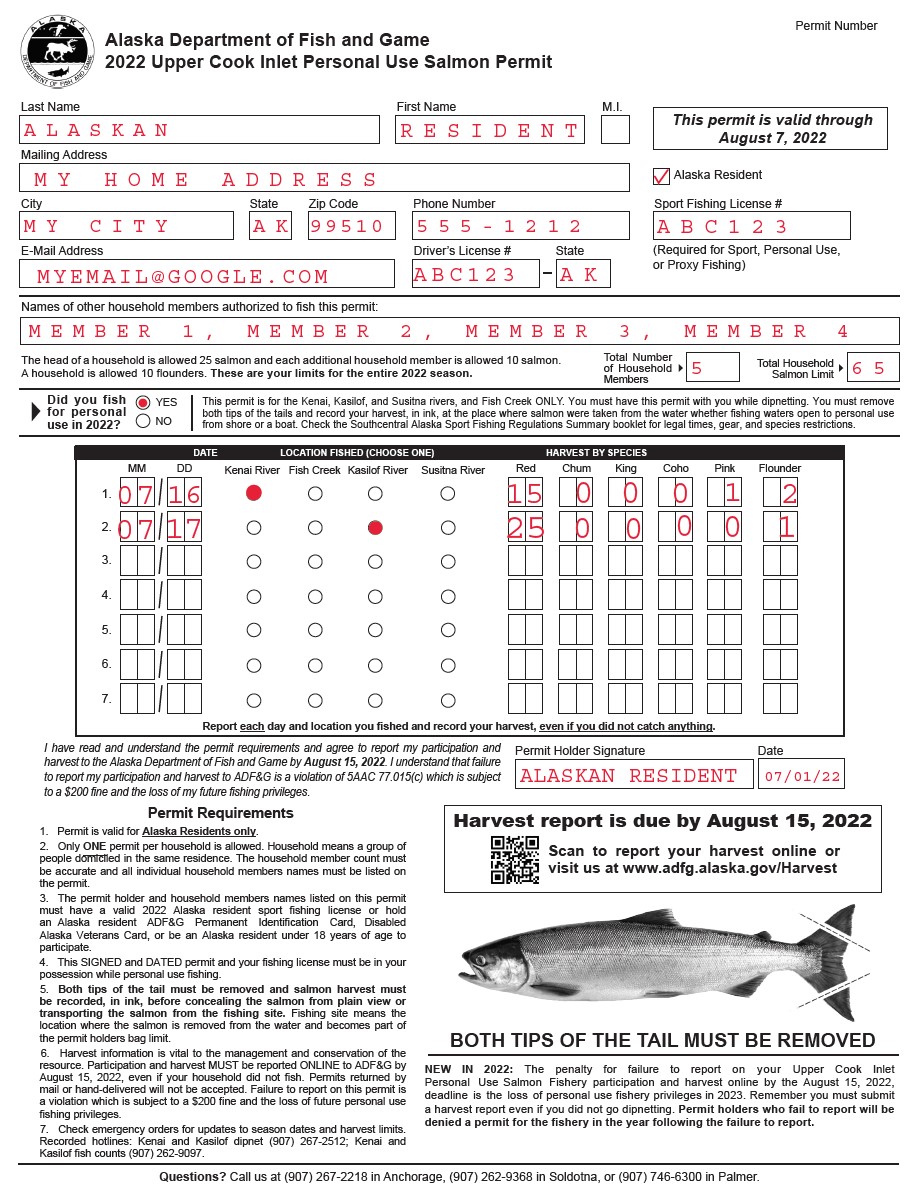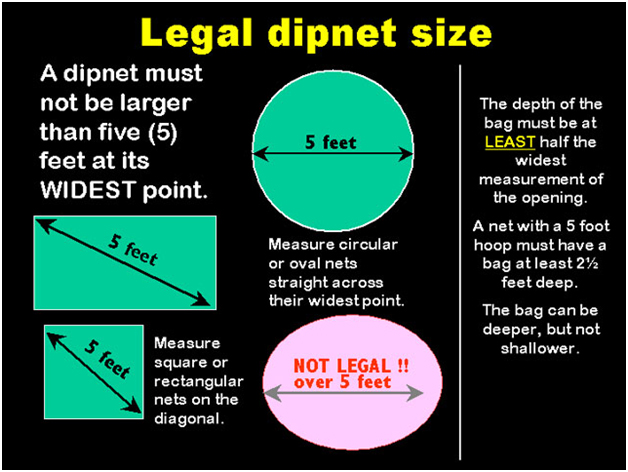Kenai River Salmon Fishery
Permits & Regulations
Kenai River Online Permits & Reporting
Online Salmon and Shellfish Permits and Harvest Reporting - More Info
Online Harvest Reporting is Required
All Upper Cook Inlet Personal Use Salmon Fishery permit participation and harvest reporting must now be completed online through the ADF&G harvest reporting webpage.
- Online reporting will be required regardless if you purchase the permit through the ADF&G online store or through a vendor.
- Returning permits by mail or hand-delivery is no longer an acceptable means to report after 2021.
Harvest and participation must be reported online no later than August 15th, even if you did not use the permit, or if you did use the permit but did not catch anything.
To report online, enter your last name, permit number, and select Upper Cook Inlet Personal Use Salmon Permit for the appropriate year.
- If you don’t have your permit number available, you can look up your permit on the webpage.
- If you have questions about online harvest reporting, please contact your local ADF&G office.
Failure to Report and the Loss of Future Fishing Privileges
Even if you did not use the permit, and even if you did use the permit but did not catch anything you still have to report.
Beginning with the 2022 fishing season, the penalty for failure to report Upper Cook Inlet Personal Use Salmon Fishery participation and harvest online by the August 15th reporting deadline is the loss of personal use fishing privileges in 2023.
Permit holders who fail to report will be denied a permit for the fishery in the year following the failure to report.
To help you remember timely harvest reporting, be sure to provide a valid email address when obtaining your permit so that you will receive a reminder email near the end of the fishing season.
Stay Updated
Additionally, you can subscribe to receive Southcentral Region II – Northern Kenai Peninsula and Mat-Su / West Cook Inlet Emergency Orders and Press Releases email notifications.
To participate in any personal use fishery, you must be an Alaska Resident, and possess a valid Sport Fishing License or ADF&G senior license or ADF&G Disabled Veteran's License.
A permit is required to personal use dipnet for salmon in the Kenai River, Kasilof River, or Fish Creek.
Permits can be obtained from private vendors or at Fish and Game offices in Fairbanks, Anchorage, Palmer, Soldotna, and Homer.
Permits are also available online through the Alaska Department of Fish and Game Online Store.
Households may not have both the Upper Cook Inlet Personal Use Salmon Permit and the Kachemak Bay Coho Salmon Set Gillnet Permit. Households must choose one or the other permit.
Personal use permits are household permits. This means that only one permit is required per household. However, all participating members of the household who are 18 years old or older must also have an Alaska resident sport fishing license, ADF&G senior license or ADF&G Disabled Veteran's license to participate, and must be named on the permit.
Permits must be filled in each time you fish
You must record the date, location, and harvest by species each time you fish. You must fill in this information even if you did not catch any fish—write "0" in the space provided for harvest.
The salmon must be recorded on the permit before it is concealed from plain view, such as put in a cooler, or before the salmon is transported from the fishing site, such as your vehicle. Failure to record the salmon on the permit is a violation, and may be subject to fines and loss of future personal use fishing privileges.
SAMPLE PERMIT

**If you did not catch any fish, put the day you went fishing, select where, and write zero's for quantity.
Personal use salmon required to be "marked"
By regulation, you must "mark" salmon harvested in a personal use fishery in which a permit is required by clipping both tips of the tail fin. Scissors or shears are the best way to cut off the tips of the tail fin.
The salmon must be marked before the salmon is concealed from plain view, such as put in a cooler, or before the salmon is transported from the fishing site, such as your vehicle. Failure to mark the salmon is a violation, and may be subject to fines and loss of future personal use fishing privileges.

Bag limits
The total yearly harvest out of all the Upper Cook Inlet personal use salmon fisheries (Kenai, Kasilof, and Fish Creek) is 25 salmon and 10 flounder for the permit holder and 10 salmon for each additional household member. The limit is combined for all four fisheries - Kenai dipnetting, Kasilof dipnetting, Kasilof set gillnetting, and Fish Creek dipnetting. King salmon may not be kept in the Fish Creek dipnet fishery.
NO RETENTION of king salmon allowed. All king salmon caught may not be removed from the water and must be released immediately.
These are annual household limits, not a daily limit, or a limit per fishery.
Legal gear: dipnet
In 5 AAC 39.105 of the Alaska Administrative Code, a dipnet is defined as:
- a bag-shaped net supported on all sides by a rigid frame;
- the maximum straight-line distance between any two points on the net frame, as measured between any two points on the net frame, as measured through the net opening, may not exceed five feet;
- the depth of the bag must be at least one-half of the greatest straight-line distance, as measured through the net opening;
- no portion of the bag may be constructed of webbing that exceeds a stretched measurement of 4.5 inches;
- the frame must be attached to a single rigid handle and be operated by hand.
This definition applies statewide, to both salmon and herring/hooligan dipnet fisheries.

